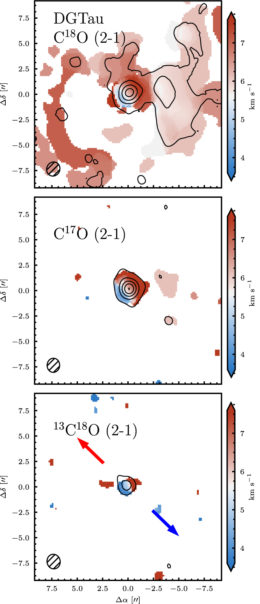Planets start their lives in disks of gas and matter around stars, so understanding these so-called protoplanetary disks is key to decoding planet formation. One interesting feature of protoplanetary disks is that they contain less carbon monoxide gas than the typical interstellar medium. When and how does this deficit arise?

Radio observations of the disk around the star DG Tau, with separate plots for each form or isotopologue of CO. The contours designate varying intensity and the colors indicate the velocity of the gas (red is faster than blue). The arrows in the bottom-most plot indicate outflows associated with DG Tau. [Adapted from Zhang et al. 2020]
Protostellar to Protoplanetary
Carbon monoxide (CO) is one of the most common compounds found in space and can be used to trace other chemical compounds along with the structure and mass distribution of objects. However, protoplanetary disks appear to lack CO gas to a startling degree relative to the interstellar medium (ISM). CO gas can be destroyed by chemical processes or be frozen out of the gas state, but these mechanisms alone can’t explain the deficit of CO gas seen in protoplanetary disks.
Protoplanetary disks are an evolved form of protostellar disks, which are created when a cloud of gas collapses to birth a star. Could CO be dissipated at this earlier protostellar disk stage? Or does the depletion only occur when the disk is older?
This question of timing is what motivated a recent study by a group of researchers led by Ke Zhang (University of Michigan). Zhang and collaborators used radio observations of three young (less than a million years old) protostellar disks to measure their levels of CO gas and compare them to that of the typical ISM.
COuld It Be at a Higher Level?
Zhang and collaborators selected their disks based on whether the disk structure could be seen in radio observations. They searched for three different forms of CO that, taken together with models, could probe the CO content of the entire disk. Different models were used to fit the disks, with adjustments to parameters like the gas-to-dust ratio and levels of molecular hydrogen.

The CO content and ages of various protostellar and protoplanetary disks. The average ISM value is shown for comparison. The disks used in this study are TMC1A, HL Tau, and DG Tau. The circles indicate disks and the squares indicate the average value for disks in star-forming regions. Disks younger than 1 million years are considered protostellar disks and disks older than one million years are considered protoplanetary disks. Click to enlarge. [Zhang et al. 2020]
What does this mean for the missing CO problem? The dropoff in CO appears to occur around the million year mark. This means that the CO depletion process is fairly rapid — on astronomical scales — and puts tight constraints on the responsible mechanisms.It also restricts the depletion to occurring within the disk rather than in the surrounding envelope of infalling gas.
It may take exploring combinations of physical and chemical processes to solve this puzzle, as well as observing a larger sample of disks. Either way, CO continues to be a useful molecule to find (or not find) in space!
Citation
“Rapid Evolution of Volatile CO from the Protostellar Disk Stage to the Protoplanetary Disk Stage,” Ke Zhang et al 2020 ApJL 891 L17. doi:10.3847/2041-8213/ab7823

2 Comments
Pingback: AASNova – PTMA Kraków
Pingback: El caso del CO perdido – Observatori Astronòmic